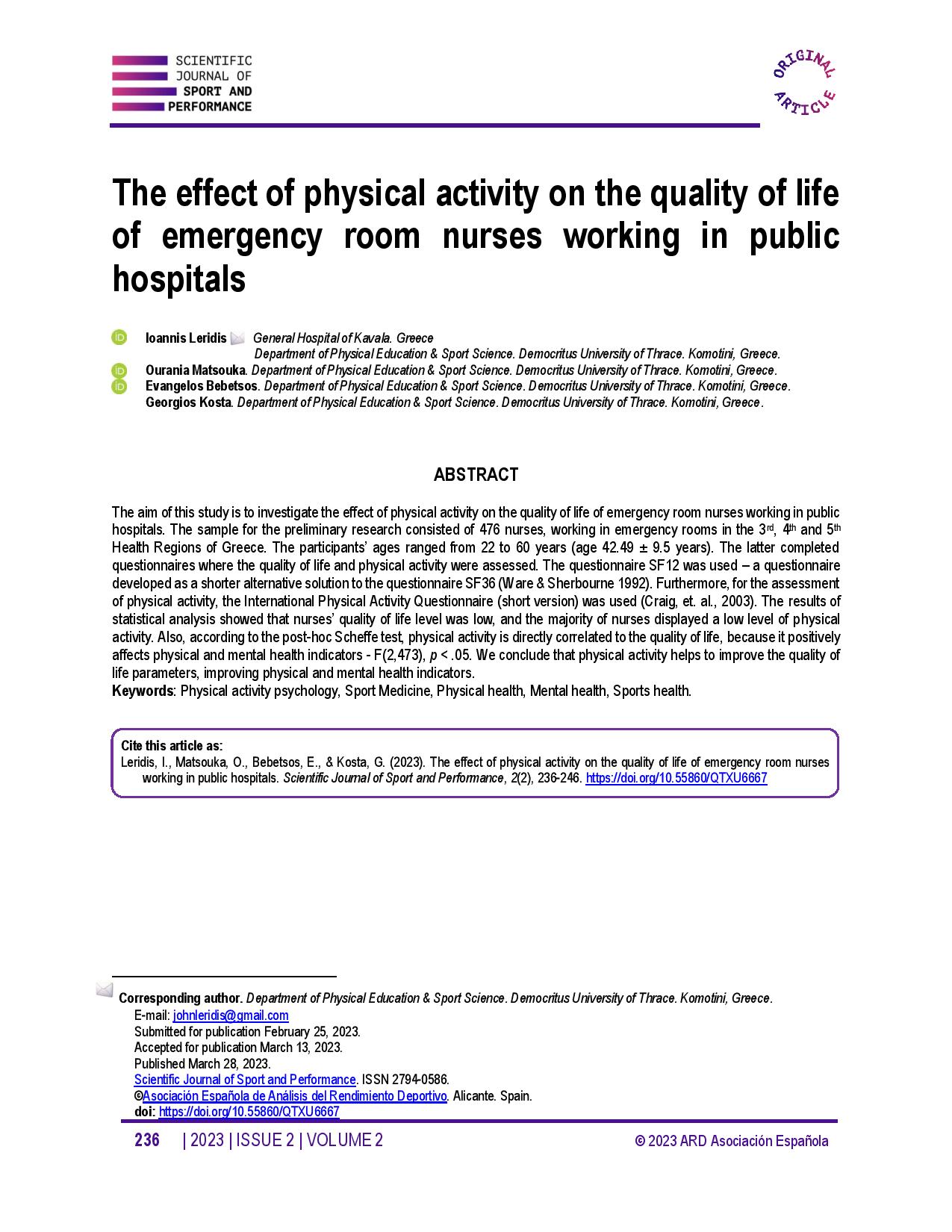The effect of physical activity on the quality of life of emergency room nurses working in public hospitals
Main Article Content
Abstract
The aim of this study is to investigate the effect of physical activity on the quality of life of emergency room nurses working in public hospitals. The sample for the preliminary research consisted of 476 nurses, working in emergency rooms in the 3rd, 4th and 5th Health Regions of Greece. The participants’ ages ranged from 22 to 60 years (age 42.49 ± 9.5 years). The latter completed questionnaires where the quality of life and physical activity were assessed. The questionnaire SF12 was used – a questionnaire developed as a shorter alternative solution to the questionnaire SF36 (Ware & Sherbourne 1992). Furthermore, for the assessment of physical activity, the International Physical Activity Questionnaire (short version) was used (Craig, et. al., 2003). The results of statistical analysis showed that nurses’ quality of life level was low, and the majority of nurses displayed a low level of physical activity. Also, according to the post-hoc Scheffe test, physical activity is directly correlated to the quality of life, because it positively affects physical and mental health indicators - F(2,473), p < .05. We conclude that physical activity helps to improve the quality of life parameters, improving physical and mental health indicators.
Article Details

This work is licensed under a Creative Commons Attribution-NonCommercial-ShareAlike 4.0 International License.
References
Adriaenssens, J., De Gucht, V., &Maes, S. (2015). Causes and consequences of occupational stress in emergency nurses, a longitudinal study. Journal of Nursing Management, 23(3), 346-358. https://doi.org/10.1111/jonm.12138 DOI: https://doi.org/10.1111/jonm.12138
Akersterdt, T., Knutsson, A., Narusyte, J., Svedberg, P., Kecklund, G., Alexanderson, K. (2015). Night work and breast cancer in women: a Swedish cohort study. BMJ Open, 50(8),2-7.
Bährer, K. S. (2018). Burnout for Experts: Prevention in the Context of Living and Working. USA: Springer.
Berger, B., Pargman, D., & Weinberg, R. (2007).Foundations of exercise psychology (2nd edition). Morgantown, WV: Fitness Information Technology.
Blake, H., Mo, P.K., Lee, S., & Batt, M. E. (2012). Health in the NHS: Lifestyle behaviours of hospital employees. Perspectives in Public Health, 132(5), 213-215. https://doi.org/10.1177/1757913912457309 DOI: https://doi.org/10.1177/1757913912457309
Brooks, B. A., Anderson, M. A. (2005). Defining Quality of Nursing Work Life.Nursing Economics,23, (6), 319-326.
Burdick, K. E., Russo, M., Frangou, S., Mahon, K., Braga, R. J., Shanahan, M. & Malhotra, A. K. (2014). Empirical evidence for discrete neurocognitive subgroups in bipolar disorder: clinical implications. Psychological Medicine, 44, 3083-96. https://doi.org/10.1017/S0033291714000439 DOI: https://doi.org/10.1017/S0033291714000439
Clarke, S. G., & Haworth, J. T. (1994). "Flow" experience in the daily lives of sixth-form college students. British Journal of Psychology, 85(4), 511-523. https://doi.org/10.1111/j.2044-8295.1994.tb02538.x DOI: https://doi.org/10.1111/j.2044-8295.1994.tb02538.x
Craig, C.L., Marshall, A.L., Sjöström, M., Bauman, A.E., Booth, M.L., Ainsworth, B.E., Pratt, M., Ekelund, U.L.F., Yngve, A., Sallis, J.F. and Oja, P. (2003) International Physical Activity Questionnaire (IPAQ): 12-Country Reliability and Validity. Medicine & Science in Sports & Exercise, 35, 1381-1395. https://doi.org/10.1249/01.MSS.0000078924.61453.FB DOI: https://doi.org/10.1249/01.MSS.0000078924.61453.FB
Fallowfield, L. (1990). Quality of life: the missing measurement in health care. London: Human horizon: Series souvenir Press.
Hornquist, J.O. (1982). The concept of quality of life.Scandinavian Journal of Social Medicine, 10, 57-61. https://doi.org/10.1177/140349488201000204 DOI: https://doi.org/10.1177/140349488201000204
Matsugaki, R. 2017. Effectiveness of workplace exercise supervised by a physical therapist among nurses conducting shift work: A randomized controlled trial. Journal of Occupational Health, 59(4),327-335. https://doi.org/10.1539/joh.16-0125-OA DOI: https://doi.org/10.1539/joh.16-0125-OA
Mohammadi, A., Sarhanggi, F., Ebadi, A., Daneshmandi, M., Reiisifar, A., Amiri, F. &Hajamini, Zahra., (2011).''Relationship between psychological problems and quality of work life of Intensive Care Unit Nurses'', Iranian Journal of Critical Care Nursing, 4(3), 135-40.
Peterson, U., Demerouti, E., Bergström, G., Samuelsson, M., Ǻsberg, M &Nygren, Ǻ. (2008).Burnout and physical and mental health among Swedish healthcare workers.Journal of Advanced Nursing, 62(1), 84-95. https://doi.org/10.1111/j.1365-2648.2007.04580.x DOI: https://doi.org/10.1111/j.1365-2648.2007.04580.x
Robin, M. & Leslie, R.M. (2006).Introduction to Health Psychology: Health reports. Athens: Greek Letters.
Rütten, A., Gelius, P & Abu-Omar, K. (2011).Policy development and implementation in health promotion - from theory to practice: the ADEPT model. Health PromotInt, 26:322-329. https://doi.org/10.1093/heapro/daq080 DOI: https://doi.org/10.1093/heapro/daq080
Silva, R. M., Beck, CL. C., Guido, L. A., Lautert, L., Tavares, J. P., Prestes, F. C., Rocha, L. (2009). Night shift pros and cons in nursing: qualitative study. Online Braz J of Nurs; 8 (2),1676-1685. https://doi.org/10.5935/1676-4285.20092346 DOI: https://doi.org/10.5935/1676-4285.20092346
Schutz, V., Shattell, M. (2020). Impact of COVID-19: What does it mean for nurses and health systems.Journal of Psychosocial nursing and Mental Health Services, 58(8):2-3. https://doi.org/10.3928/02793695-20200707-01 DOI: https://doi.org/10.3928/02793695-20200707-01
Török, S., Kökönyei, G., Károlyi, L., Ittzés, A. &Tomcsányi, T. (2006).Outcome Effectiveness of Therapeutic Recreation Camping Program for Adolescents Living with Cancer and Diabetes.Journal of Adolescent Health, 39(3), 445-447. https://doi.org/10.1016/j.jadohealth.2005.12.018 DOI: https://doi.org/10.1016/j.jadohealth.2005.12.018
Tzormpatzakis, Ν. & Sleap, Μ.(2007). Participation in physical activity and exercise in Greece: a systematic literature review. International Journal of Public Health, 52(6):360-371. https://doi.org/10.1007/s00038-007-6118-6 DOI: https://doi.org/10.1007/s00038-007-6118-6
Ventegodt, S. (1995).Quality of Life in Denmark.Results from a Population Survey.ForskningscentretsForlag, Copenhagen.
Ware, J. Kosinski, M., Keller, S. (1998). SF-12: How to Score the SF-12 Physical and Mental Health Summary Scales 2nd ed. Boston MA, The health institute.
Ware, J.E.& Stewart, A.L. (1996). Measures for a new era of health assessment.Measuring, functioning and well-being. Duke University Press, London.
Ware, J.E., &Sherbourne, C.D. (1992). The MOS 36-item short-form health survey (SF-36). Medical Care, 30(6), 473-483. https://doi.org/10.1097/00005650-199206000-00002 DOI: https://doi.org/10.1097/00005650-199206000-00002
Williamson, D.F., Vinicor, F., & Bowman, B.A. (2004). Primary prevention of type 2 diabetes mellitus by lifestyle intervention: implications for health policy. Ann Intern Med, 140(11), 951-7. https://doi.org/10.7326/0003-4819-140-11-200406010-00036 DOI: https://doi.org/10.7326/0003-4819-140-11-200406010-00036
WHO, (2021).SOWN Country Profiles NHWA Web Portal. Available at: https://apps.who.int/nhwaportal/Sown/Index[Lastaccess: April 2022].
WHO.(2019). Report of the WHO-China Joint Mission on Coronavirus Disease 2019 (COVID-19). Geneva: WHO; 2020.
World Health Organization (2004).Global strategy on diet, physical activity and health. Geneva, Switzerland: WHO.




